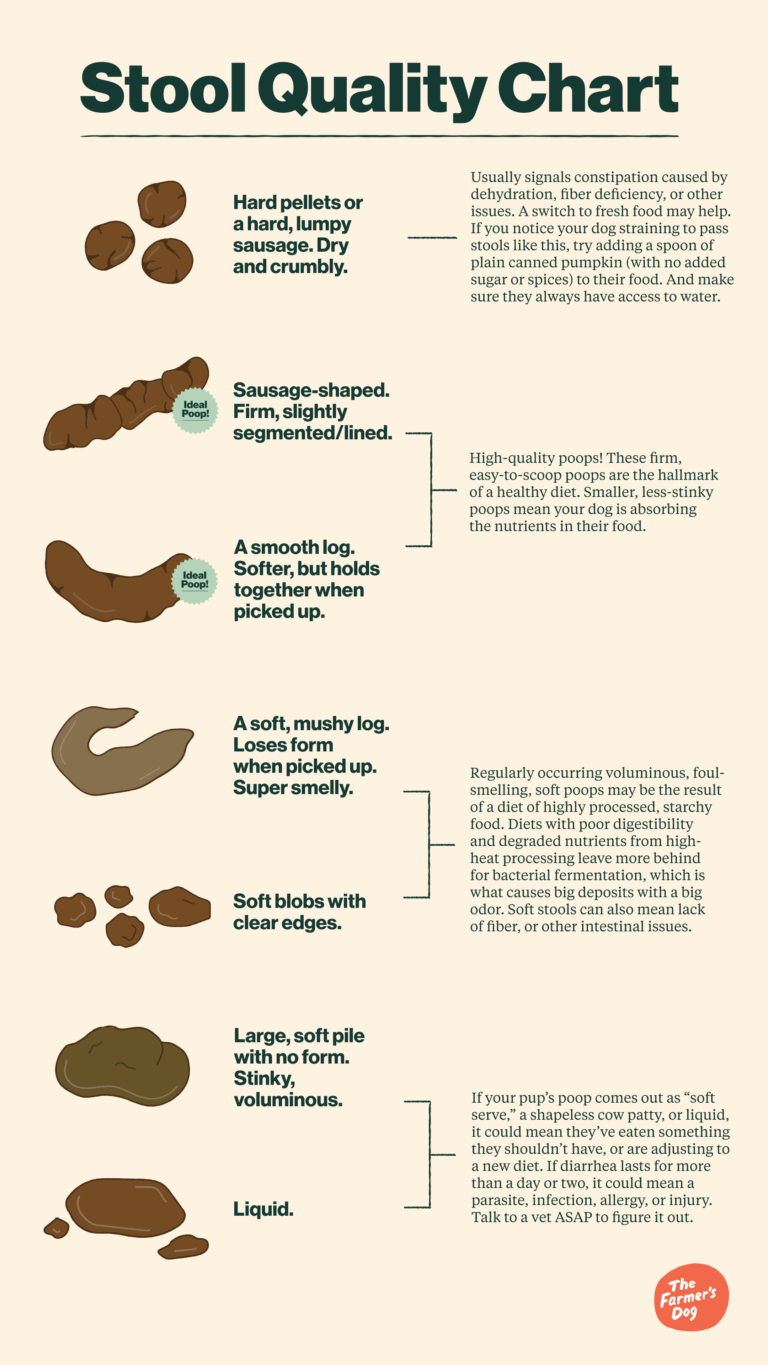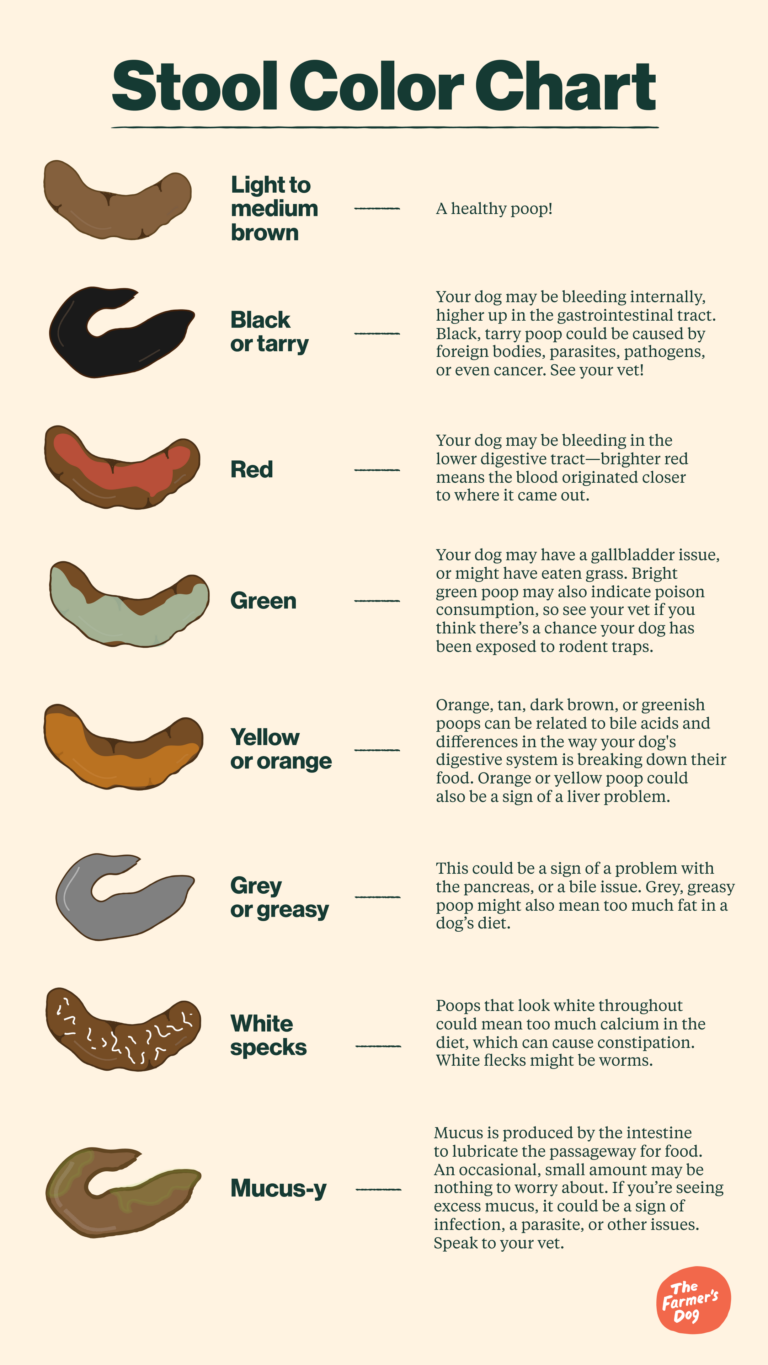When it comes to your dog’s health, sometimes the proof is in the poop. Most dog owners are familiar with a sudden change in consistency (such as a bout of diarrhea), but what about when poop suddenly turns an unusual color or changes in size or shape?
First, it helps to have an idea of what’s “normal.” As a rule, if your dog’s stools are firm, log-shaped, easy to scoop, and a chocolate-brown color, those are all good signs and point to a healthy digestive tract. However, “normal” can vary a bit from dog to dog, which is why veterinarians often advise that dog owners pay attention to their pup’s typical potty habits and output to be able to more easily identify when something may be amiss.
It may not be the most pleasant topic, but your dog’s poop is a window into their gastrointestinal system and can give you, and your veterinarian a pretty clear picture of what’s going on with their health, says Brian J. Bourquin, DVM, and owner of Boston Veterinary Clinic. “It’s why veterinarians spend so much time talking about dog poop.”
Here, some guidelines for determining what’s normal and what’s not, and the basics of “reading” your dog’s poop.
Volume and frequency (all about High Quality Poops)
The size of a dog’s stools will vary greatly depending on their individual fiber intake and the quality of the food they’re being offered. Dogs who are fed a diet of fresh food, for example, will likely produce poops that are smaller in size (and less smelly) because the food is being absorbed more effectively into the body (this is what we refer to as a High Quality Poop!). Research actually shows that fresh food and High Quality Poops are linked. A University of Illinois study showed that diets made with human-grade ingredients are palatable and extremely digestible. They compared the poops of dogs eating kibble diets and those eating fresh, human-grade diets and found that dogs fed the kibble diet had to eat more to maintain their body weight, and produced 1.5 to 2.9 times as much poop as the dogs eating human-grade fresh food. That’s more nutrition being absorbed by the dog, and less poop being scooped by the human.
When it comes to frequency, here’s where it helps to know what’s normal for your pet—some dogs have to go multiple times a day, whereas others may only defecate once each day. As long as the color and consistency of their poop appear healthy, it’s all considered completely normal. However, if your once-daily canine friend is suddenly begging to be let outside multiple times in a day, there may be something amiss, as any sudden increases or decreases in frequency could be a reflection of a digestive issue.
Consistency and shape
For the most part, your pup’s poop should be well-formed and log-shaped. A temporary change in consistency may not necessarily be cause for concern (if you’re transitioning food, or your dog snacks on just a few too many dog treats, for example), but ongoing loose stools can reflect an intestinal upset.
Color
A normal stool for a dog should be medium-to-dark brown in color. According to Dawn M. Spangler, DVM, assistant professor of shelter medicine at Lincoln Memorial University College of Veterinary Medicine in Tennessee, “the color of the stool should be fairly consistent from day to day, providing the dog eats a regular diet.”
Bits of other colors aren’t always a cause for concern, particularly if they’re reflecting something your dog may have eaten. If your dog snatched a few carrots from your dinner plate, you shouldn’t be alarmed to see some orange in their stool the next day. But pay attention if you’re seeing unusual colors that you can’t explain, or that last for more than one poop.
Black poop
Though it’s a relatively rare occurrence, when your pet’s poop suddenly takes on a black, tarry appearance, it can point to a number of digestive conditions. Black, tarry stools are often caused by something serious—bleeding in the stomach or small intestines. “The stool turns black because blood has been digested, causing it to change color,” Dr. Spangler says. Known as melena, black stool can result from a range of things, from exposure to toxins or a foreign body in the gastrointestinal system to pancreatitis and kidney failure. A few of the more common causes of black dog poop are cancer, foreign bodies, parasites, and viral or bacterial pathogens, Dr. Spangler adds. As such, black dog poop warrants a call to your veterinarian.
Red, yellow, and green poop
Red stools can also be a symptom of straining, gastroenteritis, colitis, or anal fissure, and will require veterinary intervention. If you see a small amount of bright red blood, but everything else appears normal, it may be nothing to worry about. If there’s a larger amount, or it appears more than once, consult your veterinarian as it can indicate infection, gastroenteritis, or other conditions. Other colors, like green, orange, and yellow, should also be monitored as they can be indicative of something minor like a recent change in a dog’s diet, or more serious issues like Irritable Bowel Syndrome or parasites. Green poop can indicate that your dog has eaten too much grass, or it can point to a gallbladder issue. Orange or yellow dog poop may be a sign of a biliary or liver problem.
Grey and white poop
Other colors you don’t want to see in your dog’s poop include grey/light tan, or white flecks. Grey or light tan stools can be an indicator of liver or pancreatic problems. The appearance of white flecks in a dog’s stool can be a symptom of worms, which are contagious and require immediate veterinary attention (note that ingested rice grains may also be confused for worms). And what if it’s their own white (or other color) fur that you’re finding in their poop? If your dog is frequently licking their fur (and subsequently swallowing it), furry stool can be a symptom of allergies or another skin disease.
Foreign objects
Most dogs find it hard to resist a garbage can, or their canine instincts to devour whatever plush toys they get their paws on. But if your dog steals a leftover chicken bone or plays a little too rough with their squeaky toys, you may see those objects in their poop later on. Unfortunately, if all pieces of the foreign object don’t successfully pass through their digestive system, there’s a risk of bowel obstruction—a painful and potentially life-threatening blockage of the GI tract that prevents food flow to the bowels. Vomiting is the first clue, but if your dog is not passing stool at all that can also indicate an obstruction.
Details on dog diarrhea
Many pet owners are unsure about when their dog’s loose, watery stool is something to be worried about, and when it’s a passing anomaly. First, you can start determining potential causes for the diarrhea—did they sneak some “non-approved” food earlier that day, or did their diet recently change?
If it’s a one-time bout of loose or watery stool, it’s likely not anything to worry about. If your dog has sudden diarrhea or other gastrointestinal (GI) symptoms, it can be a result of acute causes, such as stress-related colitis or “garbage gut”—a signal that your dog got into the trash.
If it’s a more chronic case, however, your veterinarian may want to perform a fecal exam to identify possible intestinal parasites, or abdominal X-rays and ultrasound to screen and visualize the gastrointestinal tract.
Pet owners should pay attention to anything else that may be out of the ordinary, between rounds of poop, as it’s often the other symptoms that accompany diarrhea that can signal trouble. According to Dr. Spangler, a vet visit is warranted if your dog is refusing to eat and/or drink water for more than 24 hours, appearing lethargic, or experiencing other symptoms like persistent vomiting or ongoing diarrhea. “They can quickly become dehydrated, so it’s better to see a veterinarian sooner rather than later to get them the care and treatment they need,” she concludes.
Mucus and blood
Dog stool often contains some mucus and it’s typically nothing to worry about. It’s a slime-like substance made by the intestines to keep the lining of the colon lubricated and moist. In fact, small amounts are often dead cells acting as a natural lubricant in the gut, helping prevent constipation. But excessive amounts of mucus in the stool may indicate a medical condition like colitis. Other causes for excess mucus in the stool include intestinal infections or parasites, dietary indiscretion, too rapid of a change in diet, adverse food reaction, or inflammatory disorders. The appearance of excess blood is also typically not normal, as it can be an indication of systemic or gastrointestinal disease.
Additionally, poop that is round, pellet-shaped, or abnormally hard can be a telltale sign that your dog is dehydrated. If your dog’s stool also appears too large relative to the amount of food they have been consuming, this could also be a sign that their meals aren’t being properly absorbed (a hallmark of dry, processed food), or increased fiber intake.
Poops during food transition
When you change your dog’s diet, even if you’re switching to whole, healthy food, it’s common to see the effects in their poop. While many people see no negative effects on digestion while they’re transitioning their dog’s food, you may see changes in consistency of your dog’s poop during this phase. This usually means looser stools or diarrhea. This should last a few days, depending on your dog, and how rapidly you’re transitioning. As long as your dog seems fine otherwise, this “transition poop” should be nothing to be concerned about.
This article was vetted by vets.
Reviewed by: Alex Schechter, DVM, and founding veterinarian at Burrwood Veterinary. He was previously founding veterinarian at Pure Paws Veterinary Care;
Melanie Shapiro, DVM;
Danielle Woolf, DVM.
Photo by Jason Leung on Unsplash.








